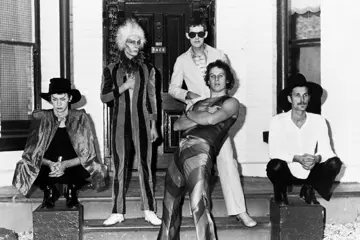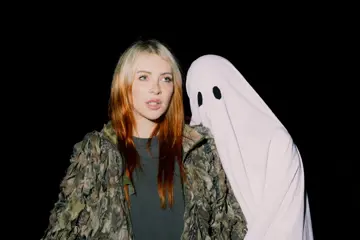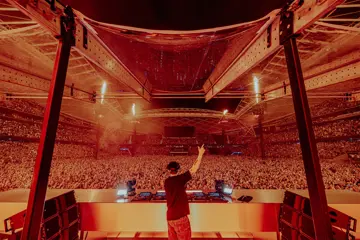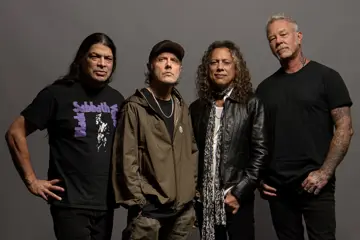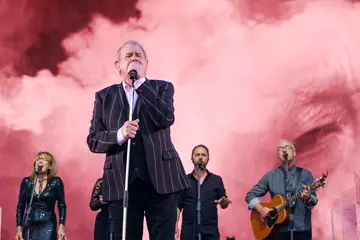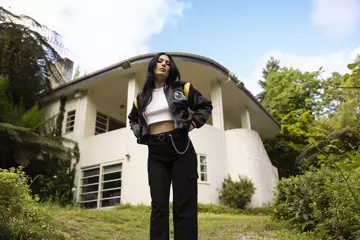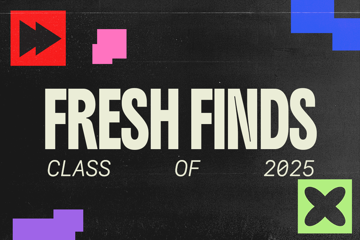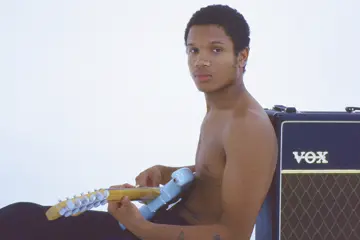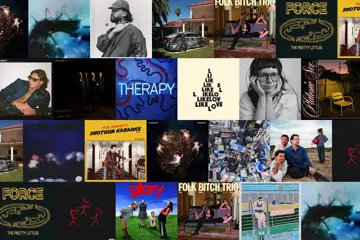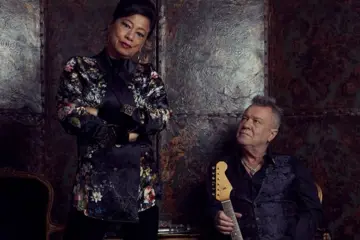 Soweto Gospel Choir
Soweto Gospel ChoirFor those wanting to feel the sweet sensation of nostalgia reverberating through their heart and eardrums or even those just wanting to better understand some of the iconic tracks that made house music, Soweto Gospel Choir and Groove Terminator have created a truly special compilation.
The South African Soweto Gospel Choir and Australian DJ Groove Terminator have created a special 11-track album called History Of House. The album recreates some of the genre’s most iconic numbers, from the beginning of house in the 1970s to the golden rave era of the ’90s and early 2000s.
A pioneer in the scene of house music for several years, Australian DJ Groove Terminator first came into contact with the choir at their Sydney Opera House performance, enamoured by their use of traditional South African heritage to create distinct melodies that soared through the acoustics of the venue.
The album, produced by Grammy-winning producer Latroit, is truly a worldly affair. Groove Terminator and the Soweto Choir explain the reasoning behind the careful curation of each song and how they’ve incorporated new elements, such as singing in multiple languages, to give the tracks new life.
Read below to see how each single came to define, and redefine, History of House.
Silence
Don't miss a beat with our FREE daily newsletter
When it came to choosing tunes for this album, this absolute Canadian classic was always on the list. I believe the song is about finding peace in the moment while surrounded by chaos; many people believe it to be about God, which also works for house music. I recorded the vocals over a basic demo, and while what we got was all felt to be pretty great, and Ipy’s lead performance is simply transcendent, the tune was parked to the side for several months while we worked on it.
We weren't that satisfied with where we were at, and then Dennis, my co-producer, suggested it might be pretty cool if we gave the choir space to do that thing they do so well without a lot of production around them as opposed to the way this song is normally best experienced - in a huge arena or field, the peak of the night with your hands in the air, singing at the top of your lungs with your mates, arm in arm. He was right, and I loved that idea. What a moment to begin the story
Troubled
Vera Hall’s Trouble So Hard from the Alan Lomax field recordings that Moby’s incredible album Play is primarily based on felt like a great song we could riff on while adding something worthy to its original story. Dennis and I felt a “dancing in a field at sunrise” Balearic-type groove reminiscent of bands like Primal Scream and The Beloved meets contemporary production was the way to move on this one. The very first time I heard Thabiso (the soloist) sing this in Zulu over the piano, I had goosebumps.
Good Life (Chantty Natural remix)
Back story - in 1992, Kevin Saunderson came back to my house and ate some pasta cooked by my girlfriend after the first time he came to Adelaide (thanks to my mate Tony who ran our local Central Station Records - a crucial social network for our scene at the time). You have to understand I had been a DJ for maybe 4-5 years by that time, and Kevin was (and still is) one of my idols/role models in our culture who had these iconic songs of my generation and a person I really I looked up to, so this was a pretty big deal for me to happen.
Cut to the late 2000s, when I met Dennis White at a Grammy party while living in LA. He told me he was the music director for Inner City, the band; well, let's just say I had a lot of questions, and we really hit it off. So when it came to choosing songs for this project, this was always on the list from the get-go. Getting Kevin’s blessing on our version has humbled me, and I love how our version came out.
The flute parts were performed by Dadisi Komolafe, who had played with legendary artists like Wayne Shorter. However, life had taken some turns, and he ended up living on the streets for a bit. This was his first time back in a studio for many years. The power of music never ceases to amaze me.
Smash sings this so beautifully, personifying that aching, yearning joy of the song's intent for me while also paying homage to that iconic Paris Grey vocal embedded in the DNA of a generation of clubbers. Being the first single we were going out with and wanting to include as much African talent as possible to showcase on the remixes, Dennis then helped kick off this cultural exchange program in South Africa called Orna Create with the help of the Johannesburg Chamber of Commerce Youth Commission which gave us the incredible Chantty Natural version you hear on our album.
World, Hold On
World, Hold On is about unity, love and togetherness, which is what we are all about too. Shimmy’s performance in language highlights that World Hold On, originally by Parisian DJ Bob Sinclar & Steve Edwards, is not just another dance floor banger but a rallying cry for a more conscious and united global community. I don’t feel one song can really change the world, but a great tune CAN change your world for a few minutes.
Phumula
Phumula started life as a remix of Soweto Gospel Choir’s version of Sechaba from their last album. Sechaba is from the Sarafina soundtrack, written and performed by the legendary Hugh Masekela, who sadly passed away a few years ago. Phumula is a Zulu word for rest or relaxation, and we put this here as a moment to reflect.
Everybody’s Free (Stakev Remix)
Originally performed by Zambian artist Rozalla, it was, of course, a massive global hit back in the early ‘90s. Its uplifting lyrics and euphoric production have made this such an iconic tune, and I couldn't think of a more perfect song for us to do as a group. When the Orna Create project gave us this amazing remix by Stakev, we knew this was someone we wanted to showcase on the album, along with Ipy’s soulful delivery.
Ride Like The Wind
On paper, “A sung in language, afro house take on a yacht rock classic” sounds like potentially a hot mess, but when our US label let us know they owned this song and we could use some samples from the original recording, I was instantly curious to what that blend might sound like.
The iconic Dave Lee fka Joey Negro remix is arguably one of the greatest remixes of all time, and we didn’t want to just make a poor photocopy of that, so we started with the strings from the original multitrack and built it up from there.
Along with Dennis’ deft programming and great percussion from Chase Jackson, Pam's electrifying vocals fuse together wonderfully to create this new euphoria-driven statement. The last two minutes of this track give me goosebumps every single time! Pamela throws down killer adlib after killer adlib, and the song just transports you into another dimension. It's probably my favourite track on the album.
Pride (A Deeper Love)
We've been opening our show with this decree of inner strength anthem, originally written by the almighty Robert Clivillés and David Cole, AKA C+C Music Factory, and defined for all time with Aretha Franklin singing in various ways for a while now. Given its position in the culture, I always felt this was going to be one of the first few tunes that we should make.
Sibongile’s performance has me in tears every time. She sang it so beautifully and emotively that when it came time how to house (no pun intended) this incredible vocal, it felt like we just needed to go gently and gently and let its power lift us up. I felt It should sound like “a new dawn”, and Dennis understood the brief. Barely touching our original demo, we pretty much just smoothed out the rough edges, and Dennis displays some exceptionally gentle tenderness on the sonics and mix. Dennis decided to treat the Choir like a sample of a choir on this was inspired.
Free
A perfect example of authentic house music crossing over, stunning, immediate and without compromise on any part of it. Ultra Nate is such an icon in the culture and we really wanted to honour the work while adding our own interpretation to its story. Zinhle has this magical quality in her voice that has this “Quiet Storm” thing about it and transports it into another realm.
Once you have this, how the rest of it should sound just reveals itself, eventually. As heard here and all through the songs, you can hear sprinkles of the choir just being themselves in the background. For me, this is the “Umami” of the choir. This is what it's like being on stage with the choir each night, and it transports me right there every time. It adds this extra layer of humanity, which we could all use more of, and is displayed so gloriously towards the end.
Children
We wanted to pull back and have a moment that feels like you're sunken back in the seats, finally heading home with a low throbbing emotional groove coming from the sound system cocooning you, knowing you just had a brilliant night out. Our version of an instrumental trance tune the late Italian DJ Robert Miles said was about asking kids to chill out, slow down and stay alive while driving home from the rave.
You Got The Love
The very first song we recorded for this. As far as I'm concerned, this is the Lord's Prayer meets the national anthem for house music. The message is love, and love is the message. We love house music, and we've come to save your soul! It was always song #1 that we recorded. It doesn't come bigger than this. Pam absolutely shines, and all we needed to do was support that sympathetically with the sound design. Thank you for listening.
History Of House is out now via Music Is Fun. You can listen to the album here.




